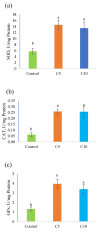Effect of Treating Eggs with Coenzyme Q10 (CoQ10) on Growth Variables, Histomorphometry, and Antioxidant Capacity in Red Tilapia (Oreochromis aureus × Oreochromis mossambicus) Larvae
- PMID: 36077939
- PMCID: PMC9454522
- DOI: 10.3390/ani12172219
Effect of Treating Eggs with Coenzyme Q10 (CoQ10) on Growth Variables, Histomorphometry, and Antioxidant Capacity in Red Tilapia (Oreochromis aureus × Oreochromis mossambicus) Larvae
Abstract
Red tilapia eggs one day post fertilization (dpf) were exposed to coenzyme Q10 (CoQ10) at rates of 0, 5, and 10 mg/L for control, treatment 2 (C5), and treatment 3 (C10), respectively, without exchanging water and until the larval mouth-opening stage. Fertilized eggs of red tilapia exposed to different concentrations of CoQ10 were hatched at rates (p > 0.05) between 38 to 54.67%. The yolk-sac diameter at the 2nd day post hatching (dph), ranged from 1.85 to 1.87 mm in depth and 1.63 to 1.88 mm in width and was not altered by the CoQ10 treatments. Similarly, red tilapia survival (p > 0.05) ranged from 22.67 to 32%. On 6 dph, a slight percentage (2.08%) of survived fishes exposed to high CoQ10 dose (C10) exhibited larval deformation in the form of an axial curvature of the spine in the abdominal and caudal region. Larvae displayed a normal structure of the esophagus folds in all fish groups, and larvae in the C5 group displayed the longest folds and widest muscularis layer, followed by fishes in the C10 group and the control. Red tilapia fry on 30 dph treated with CoQ10 possessed higher antioxidant potentials in terms of superoxide dismutase (SOD), catalase (CAT), and glutathione peroxidase (GPx) compared to the control. In conclusion, treating Red tilapia fertile eggs with 5 mg/L CoQ10 improves the growth, gut structure, and antioxidant efficiency of the produced larvae.
Keywords: CoQ10; Red tilapia; antioxidants; gut histology; larvae.
Conflict of interest statement
The authors declare no conflict of interest.
Figures





Similar articles
-
Assessing the effectiveness of CoQ10 dietary supplementation on growth performance, digestive enzymes, blood health, immune response, and oxidative-related genes expression of Nile tilapia (Oreochromis niloticus).Fish Shellfish Immunol. 2020 Mar;98:420-428. doi: 10.1016/j.fsi.2020.01.052. Epub 2020 Jan 27. Fish Shellfish Immunol. 2020. PMID: 32001349
-
Ontogeny of corticotropin-releasing factor and of hypothalamic-pituitary-interrenal axis responsiveness to stress in tilapia (Oreochromis mossambicus; Teleostei).Gen Comp Endocrinol. 2004 Dec;139(3):251-65. doi: 10.1016/j.ygcen.2004.09.013. Gen Comp Endocrinol. 2004. PMID: 15560872
-
Toxicological effects of polyethylene microplastics on growth, antioxidant capacity, histopathology and stress-related genes transcription in Asian seabass (Lates calcarifer) larvae.Chemosphere. 2025 Jun;379:144419. doi: 10.1016/j.chemosphere.2025.144419. Epub 2025 Apr 22. Chemosphere. 2025. PMID: 40267766
-
Coenzyme Q10 supplementation and oxidative stress parameters: a systematic review and meta-analysis of clinical trials.Eur J Clin Pharmacol. 2020 Nov;76(11):1483-1499. doi: 10.1007/s00228-020-02919-8. Epub 2020 Jun 25. Eur J Clin Pharmacol. 2020. PMID: 32583356
-
Discovering the Potential Value of Coenzyme Q10 in Oxidative Stress: Enlightenment From a Synthesis of Clinical Evidence Based on Various Population.Front Pharmacol. 2022 Jul 14;13:936233. doi: 10.3389/fphar.2022.936233. eCollection 2022. Front Pharmacol. 2022. PMID: 35910386 Free PMC article.
Cited by
-
Effects of Liposomal Vitamin C, Coenzyme Q10, and Bee Venom Supplementation on Bacterial Communities and Performance in Nile Tilapia (Oreochromis niloticus).Biology (Basel). 2025 Mar 19;14(3):309. doi: 10.3390/biology14030309. Biology (Basel). 2025. PMID: 40136565 Free PMC article.
-
Neem leaf powder (Azadirachta indica) mitigates oxidative stress and pathological alterations triggered by lead toxicity in Nile tilapia (Oreochromis niloticus).Sci Rep. 2023 Jun 6;13(1):9170. doi: 10.1038/s41598-023-36121-4. Sci Rep. 2023. PMID: 37280317 Free PMC article.
-
Anxiety of microbially synthesized Fe3O4-SPIONs on embryonic/larval ontogeny in red tilapia (Oreochromis sp.).Appl Microbiol Biotechnol. 2025 Jan 7;109(1):3. doi: 10.1007/s00253-024-13386-x. Appl Microbiol Biotechnol. 2025. PMID: 39777547 Free PMC article.
-
The influence of the gut microbiome on ovarian aging.Gut Microbes. 2024 Jan-Dec;16(1):2295394. doi: 10.1080/19490976.2023.2295394. Epub 2024 Jan 3. Gut Microbes. 2024. PMID: 38170622 Free PMC article. Review.
-
Effects of Different Aquafeed Sources on Growth Performance, Oxidative Capacity, and Fatty Acid Profile of Three Carps Reared in the Semi-Intensive Composite Culture System.Aquac Nutr. 2023 Dec 20;2023:3436607. doi: 10.1155/2023/3436607. eCollection 2023. Aquac Nutr. 2023. PMID: 38152155 Free PMC article.
References
-
- Zaki M.A.A., Alabssawy A.N., Nour A.E.-A.M., El Basuini M.F., Dawood M.A.O., Alkahtani S., Abdel-Daim M.M. The impact of stocking density and dietary carbon sources on the growth, oxidative status and stress markers of Nile tilapia (Oreochromis niloticus) reared under biofloc conditions. Aquac. Rep. 2020;16:100282. doi: 10.1016/j.aqrep.2020.100282. - DOI
-
- Cámara-Ruiz M., Santo C.E., Gessner J., Wuertz S. How to improve foraging efficiency for restocking measures of juvenile Baltic sturgeon (Acipenser oxyrinchus) Aquaculture. 2019;502:12–17. doi: 10.1016/j.aquaculture.2018.12.021. - DOI
-
- Hannon C., Officer R.A., Le Dorven J. Review of the technical challenges facing aquaculture of the European abalone Haliotis tuberculata in Ireland. Aquac. Int. 2013;21:243–254. doi: 10.1007/s10499-012-9584-7. - DOI
LinkOut - more resources
Full Text Sources
Miscellaneous

